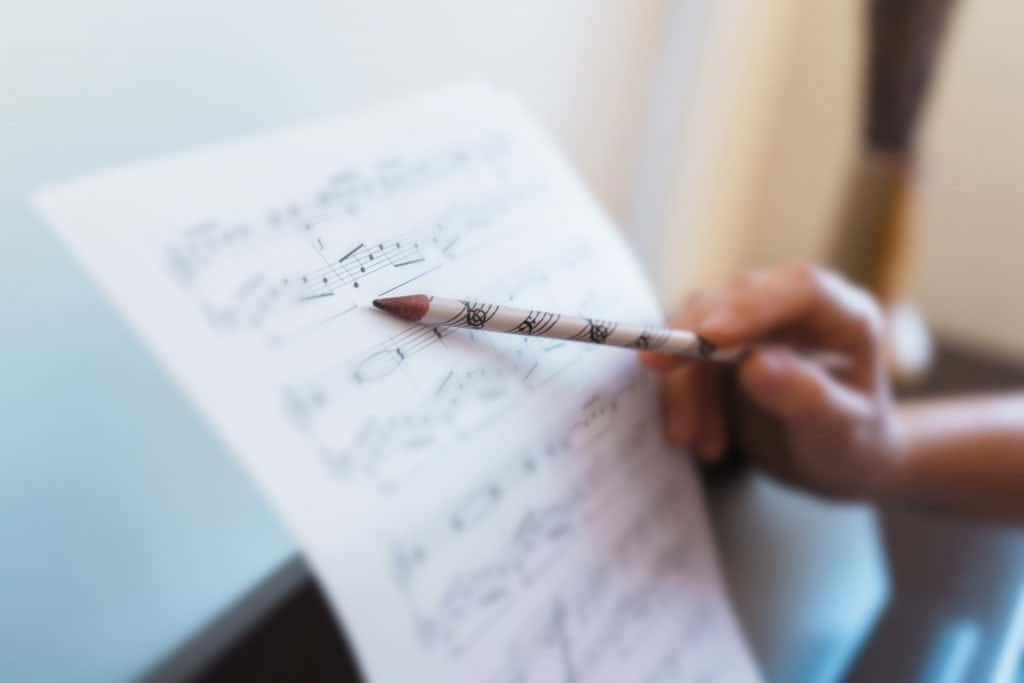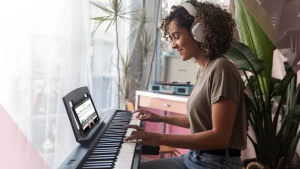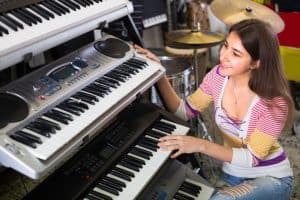The more you practice piano, the faster you will improve. That is a basic fact of piano playing that we all must deal with. However, we do not always have access to the piano, even when we want to practice. Fortunately, it is possible to practice music away from the piano!
This week we will dive into some strategies we can use to practice music away from the piano. Often, these types of practices help us to expand our general musician skills, not just the piano specific movements that we practice with the instrument.
- Fall in love with the music - Learn your favorite songs, at a level suitable for you.
- Enjoy interactive piano lessons - Explore courses covering music theory, technique chords & more.
- Get real-time feedback - Skoove's feedback tells you what went well and what needs practice.

Can I practice piano without a piano?
Yes of course, it is possible to practice piano without a piano. It is even simpler to practice pure musical skills such as rhythm and pitch away from the piano. We can use various techniques to practice away from the instrument. Examples include visualization exercises with musical scores, rhythmic piano learning games, pitch games, and bodily awareness exercises.
Using visualization as a practice technique
Visualizing your piano practice is an effective way to practice away from the instrument. Best of all, you can practice visualization in many places. For example, if you are traveling long distance, you can practice visualizing on an airplane, bus, or train.
How to practice visualization
You can practice visualization in many different ways. For example, you can practice purely imagining playing the piano keys in your mind. Practice visualizing yourself practicing the basic warm up and scale exercises you do. Imagine moving your hands on the keys. The more clearly you can picture yourself doing this, the more effective it will be.
Think of all the times you see professional athletes or performers close their eyes before they begin. They are visualizing what they are about to do in order to put themselves in the proper mindset to perform. We can use these same tactics to practice music away from the piano.
Visualizing scores
We can also practice away from the piano by using our notated scores. Try this out with any sheet music you have. While looking at the sheet music, visualize yourself practicing the music. You can break it down even further by just visualizing yourself practicing the hands separately. This is a great way to assist you in memorizing the music as well!
You can do this as well with music that you have never played. The next time you are traveling away from your piano, bring along some sheet music that you have never played. Try to sit and imagine yourself playing the music. This is a great way to build your imagination skills, as well as your rhythm and pitch training. Additionally, practicing like this will help you learn to read piano sheet music faster.
Rhythm practice
Practicing away from the piano presents awesome opportunities to practice our rhythm. There are many great ways to do this. We can practice different rhythms in music while listening to songs we enjoy.
For example, put on a pop song that you like. See if you can tap your foot on the first beat of every measure. What about the third beat? Once you can do that, try to tap your foot and second and fourth beats. Can you identify which beat the snare drum is playing on or which time signature the piece is in?
You can also practice rhythms by clapping or tapping on your body. Try this: start by tapping a basic pulse on your knees with both hands. These are quarter notes. Then, try to switch your right hand to eighth notes. You will be tapping twice as fast in your right hand than in your left hand. If it feels uncomfortable or you get thrown off, keep trying. Switch between your hands until you can move between them quite easily. There are many different ways to practice rhythms between your hands like this.
You can also adapt the score visualization practice to a pure rhythm practice. Look at any piece of music and see if you can count out the rhythm. You can do it in your head, by tapping on your knees, or clapping. This is a great way to develop your pure rhythmic skills aways from the piano.
Pitch and ear training practice
Practicing pitch and ear training is another great musical skill we can develop away from the piano. Pitch in music might be slightly more difficult to imagine for some people compared to rhythm, but nonetheless there are a handful of solid strategies we can use to develop our ears away from instruments.
For example, we can practice identifying parts of music by ear. We can either try to identify specific pitches, key centers, chord changes, or even instrumentation.
Listen back to the pop song from your rhythm practice. Can you sing the melody of the chorus in your head? What about the bassline? Are you able to name any of those pitches or recognize any of the intervals? Can you identify the main key center of that song? Or any of the chord changes? These are all great skills we can develop by practicing away from the piano.
You can also adapt this same idea to the score practice, like we did with rhythm and visualization. Try now to look at the pitches of the sheet music you brought with you and attempt to sing, internally if you wish, the different parts of the song. Of course, with more complicated music you will not be able to sing all the parts, but try to identify what you can.
Physical exercises
Finally, there are some physical strategies you can use to practice while you are away from the piano notes. Examples of physical strategies include:
- Practicing proper finger shape and relaxation
- Finger exercises performed on table tops or other flat surfaces
- Rhythmic drills in the fingers
- Practicing entire pieces of music on table tops or other flat surfaces
More learning options
Of course, practicing with online piano lessons or a learn piano app is another great way to exercise your musical skills even when you do not have direct access to a piano. If you have your phone or tablet, you can use it to practice repertoire or other lessons with Skoove or read from our extensive collection of articles on music theory and piano topics. There is always a new musical world to explore, even when you are away from the piano!
Tying it all together
Finding time to practice consistently can be a challenge for many people. Between juggling busy lives and engagements, it can feel difficult to progress in a meaningful way. Fortunately, there are many strategies we can use to practice music away from the piano.
Next time you are away from the piano, try practicing some of these strategies. Visualize yourself practicing some new sheet music. Try tapping out new rhythms or listening to a chord change to identify its properties. Try playing through some repertoire on the table top at the coffee shop.
This way, we end up spending much more time thinking about and engaging with music and will most likely have more satisfying results when the time comes to practice with the instrument again!
Author of this blog post:

Eddie Bond is a multi-instrumentalist performer, composer, and music instructor currently based in Seattle, Washington USA. He has performed extensively in the US, Canada, Argentina, and China, released over 40 albums, and has over a decade experience working with music students of all ages and ability levels.














